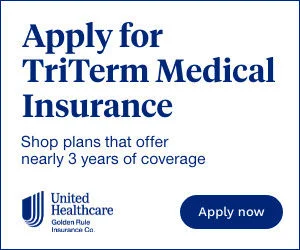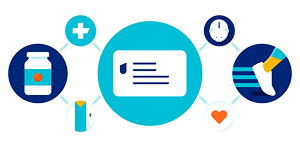- How important are prescription drugs?
- Are prescription drugs covered by health insurance?
- Are prescription drugs covered by Medicare?
- How does prescription drug coverage work?
- What will I pay for my prescriptions?
- What is utilization management?
- What happens if my prescription is not covered by my health plan?
- What are my options if I don’t have prescription drug coverage?
Do you take any prescription medications? Most Americans do. Nearly 50% of Americans take at least 1 prescription drug per month, and about 13.5% take 5 or more. And all those prescriptions can add up. In 2023, prescription drug spending hit $449.7 billion.
Numbers like those show why prescription drug coverage is important. Let’s look at how your health insurance can help you pay for your prescriptions and how you can save money when you visit the pharmacy.
Did you know some prescriptions can be written virtually? Explore a telehealth membership.
Prescription drugs are used to treat everything from infections to mental health problems to chronic conditions such as high cholesterol and diabetes.
“More times than not, you’re going to end up with some sort of prescription to treat whatever you went to the doctor for,” says Levi Sanderson, Pharm.D. He’s a clinical solutions specialist at AdhereHealth, a company that helps health plans improve members’ medication adherence (i.e., taking medicine as prescribed by their doctor).
Brian Staiger, Pharm.D., agrees. He’s the editor-in-chief of HelloPharmacist, which provides free answers to pharmacy and drug-related questions. “As a pharmacist, I strongly believe that prescription drugs are indispensable for treating a wide range of short- and long-term conditions,” he says. “It’s remarkable how medication has transformed modern medicine, making once-incurable ailments now manageable.”
That said, Staiger notes that your doctor and care team should carefully weigh the benefits and risks of every drug they prescribe. The goal is to maximize your health benefits with as few drugs as possible.
Whether you have drug coverage depends on how you get your health insurance. Under the Affordable Care Act (ACA), prescription drugs are considered an essential health benefit, along with medical services such as preventive care and hospitalization.
The ACA governs both individual health plans and group plans offered by small employers (generally those with less than 50 employees). If you buy your health insurance through the federal marketplace, your benefits plan must cover prescription drugs.
If you get health insurance through a large employer, your health plan may or may not include drug coverage. Check with your benefits administrator for more information.
Even though they’re not required to, there’s a good chance your employer’s health plan covers prescription drugs, says Staiger. According to a KFF survey, 99% of large group employer health plans include some kind of prescription drug coverage. But prescription drug plans can vary greatly.
Need to fill a prescription? Teladoc Health’s HealthiestYou telehealth membership can help you save on prescriptions. Explore telehealth options today.
Original Medicare (Medicare Parts A and B) generally doesn’t cover prescription drugs, although there are some exceptions. For example, Part A (hospital insurance) covers drugs that are part of the treatment you get while you’re an inpatient at the hospital. And Part B (medical insurance) covers things such as injected and infused drugs, such as vaccines, given by a licensed medical provider.
“You’re not going to get medication coverage out of traditional Medicare that the average person would consider prescription drug coverage,” Sanderson says. “Almost anything you go to the pharmacy for is not going to be covered on there.”
To get broader coverage, you have 2 options: a standalone Medicare prescription drug plan (Part D) or a Medicare Advantage plan (Part C) that includes drug coverage.
By the way, if you don’t buy prescription drug coverage when you first get a Medicare plan, you may face a penalty. For each month you wait to sign up, you’ll pay an additional 1% of the current “national base beneficiary premium” — $36.78 in 2025 — when you do enroll. And you’ll keep paying the penalty fee as long as you have Medicare drug coverage.
For example: If you wait a year (12 months) to enroll in a Part D plan, you’ll pay an additional 12% of the national base premium — $4.41 — on top of your monthly premium for your plan.
With prescription drug coverage, your insurance pays some or all of the cost of your prescription drugs. But not every plan covers every drug.
Each insurance company typically maintains a prescription drug list (also called a PDL or formulary). This is a list of commonly used brand-name and generic drugs covered by the plan, including the approved dosages. The PDL may vary by the type of plan you have, and the list is broken down into tiers based on cost. You can find your plan’s PDL on your insurance company’s website.
Many higher tier drugs have lower cost alternatives in a lower tier. These are either generic equivalents or other drugs that treat the same condition.
When your doctor prescribes you a medicine, you can check your plan’s drug list to see what tier the drug falls in. Your plan benefits may vary, depending on the tier. If it’s a higher tier (and more expensive) drug, you can ask your doctor if a cheaper, lower tier alternative could work for you.
“You always have the option of getting what the prescriber wrote for you,” Sanderson says. “But sometimes that means you’re going to have to pay extra or you’re going to have to cover it all yourself.”
He also emphasizes the value of generic medications, which are required by the U.S. Food and Drug Administration to work in the same way as their brand-name counterparts.
“A generic medication is going to be cheaper for the patient, cheaper for the insurance company and cheaper for the pharmacy,” he says.
Each time you get a covered prescription filled, you’ll pay either a set amount, called a copayment (or copay), such as $25 for a tier 1 drug, or a percentage of the cost, such as 50% for a tier 4 drug. Depending on your health plan, you may be solely responsible for paying the full cost until you meet your annual deductible. Some plans may also have limits on the total prescription expenses covered.
“Utilization management” is an effort to keep costs down by encouraging providers to prescribe the most affordable drug options for patients. It also helps with safe and appropriate dosing of prescription medicines.
This is done through limits and requirements on certain drugs. Next to some drugs on your plan’s drug list, you might find limits such as:
- Prior authorization: Requires your doctor to provide information about why you are taking a medication to determine how it may be covered by your plan.
- Step therapy (referred to as First Start in New Jersey): May require prior authorization for certain medications and may require you to try one or more other medications first.
- Quantity limit: Specifies the largest quantity of medication covered per copayment or in a defined period of time.
“Some patients — as well as doctors and pharmacies — can view it as a pain, but in the end, they’re trying to make sure that we’re using the most appropriate things we can that are available out there,” Sanderson says.
Your doctor may not know whether a medicine is covered by your insurance when they prescribe it. If you get all the way to the pharmacy only to find out your prescription isn’t covered, the pharmacist and your doctor might be able to come up with an alternative.
Plans governed by the ACA must include at least 1 drug in each category and class as defined by the U.S. Pharmacopeia. “If the category is antihypertensives (e.g., medications for blood pressure), classes within that category would include ACE-inhibitors (e.g., lisinopril), beta-blockers (e.g., metoprolol) and so on,” Staiger says.
If your doctor prescribes something that isn’t covered, your health plan may be able to cover another drug that treats the same condition. That could be a generic version or a “therapeutically equivalent” drug.
For example, let’s say you were prescribed a brand-name drug that treats high blood pressure. But it isn’t covered by your plan. Your plan might cover the generic version (lisinopril), or it might cover an equivalent brand-name drug.
“There are a lot of high–blood pressure medications that will do the same thing as the other ones. Some are more expensive; some are newer and some are older. And a lot of times there are very few differences,” Sanderson says. Ask your doctor or pharmacist if there is another medicine on your plan’s drug list that you can take instead.
If you and your doctor aren’t satisfied with what’s covered, you can request an exception from your insurer. Your doctor will explain that other drugs aren’t as effective for you or that they have harmful side effects. Many insurers may cover the requested drug during this process. Check your insurer’s website for complete details on requesting an exception (and, if necessary, how to appeal the decision if you disagree with the coverage determination).
If you’re uninsured or your health plan doesn’t cover prescription drugs, you may be able to get help in other ways, including discount cards, drug company discounts and patient assistance programs.
- Discount cards give you access to discounts on both brand-name and generic drugs at participating pharmacies. These are sometimes included with health plans instead of full prescription drug coverage. Or you can sign up for one on your own. The savings can be significant — in some cases you may pay less with a discount card than with insurance. They are not considered a form of insurance.
- Drug company coupons help reduce the cost of specific medications. These discounts come directly from the drug manufacturer in the form of coupons or rebates. Discounts are usually on brand-name drugs, so you’ll still want to ask about generic alternatives. The brand-name drug may still be more expensive than the generic version, even with a discount.
- Patient assistance programs offer free or low-cost prescriptions to people who can’t afford their medications. Patient assistance programs (PAPs) can offer the most help. But you have to meet certain income requirements to qualify, notes Sanderson. PAPs are typically offered by drug companies, but some state agencies and nonprofit organizations offer them, too, says Staiger. “An example of a state-run program is EPIC (Elderly Pharmaceutical Insurance Coverage) in New York.”
If you have to pay out-of-pocket for your prescriptions, it’s a good idea to shop around. “Some pharmacies may offer lower prices than others, so it’s worth doing some research to find the best option,” Staiger says. “Online pharmacies can also offer lower prices and the convenience of home delivery.”
The most important thing is to get (and take) the medications you need. They’re often the best way to get well or to manage a chronic condition.
Compare prescription drug prices via the HealthiestYou By Teladoc® telehealth platform. Learn more about what the telehealth plan offers here or contact a licensed insurance agent 1-844-211-7730.
For informational purposes only. This information is compiled by UnitedHealthcare, and/or one of its affiliates, and does not diagnose problems or recommend specific treatment. Services and medical technologies referenced herein may not be covered under your plan. Please consult directly with your primary care physician if you need medical advice.
Sources:
Centers for Disease Control and Prevention. “Therapeutic drug use.” October 7, 2024. Retrieved from https://www.cdc.gov/nchs/fastats/drug-use-therapeutic.htm
Centers for Medicare and Medicaid Services. “Drug coverage under different parts of Medicare.” Retrieved from https://www.cms.gov/outreach-and-education/outreach/partnerships/downloads/11315-p.pdf Accessed April 7, 2025
Centers for Medicare and Medicaid Services. “NHE fact sheet.” Retrieved from https://www.cms.gov/Research-Statistics-Data-and-Systems/Statistics-Trends-and-Reports/NationalHealthExpendData/NHE-Fact-Sheet Accessed March 20, 2023
Healthcare.gov. “Getting prescription medications.” Retrieved from https://www.healthcare.gov/using-marketplace-coverage/prescription-medications/ Accessed April 7, 2025
Healthcare.gov. “What marketplace health insurance plans cover.” Retrieved from https://www.healthcare.gov/coverage/what-marketplace-plans-cover/ Accessed April 7, 2025
Internal Revenue Service. “Affordable Care Act tax provisions for small employers.” April 4, 2025. Retrieved from https://www.irs.gov/affordable-care-act/employers/affordable-care-act-tax-provisions-for-small-employers
KFF. “A current snapshot of the Medicare Part D prescription drug benefit.” October 9, 2024. Retrieved from https://www.kff.org/medicare/issue-brief/a-current-snapshot-of-the-medicare-part-d-prescription-drug-benefit/
KFF. “2024 employer health benefits survey.” October 9, 2024. Retrieved from https://www.kff.org/report-section/ehbs-2024-section-9-prescription-drug-benefits/
Optum Perks. “Save money on prescriptions instantly with Optum Perks.” March 24, 2025. Retrieved from https://perks.optum.com/blog/how-do-prescription-discount-cards-work
Compliance code:
49797-X-0425










